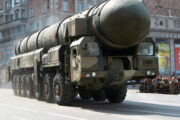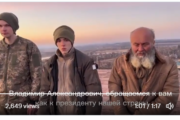THE CROAT EXTERMINATION CAMP
ON THE DAY OF REMEMBRANCE
OF GENOCIDE VICTIMS 2004
(Jasenovac, April 22, 1945)
By Dr Milan Bulajic
Founder and until 2002 Director, The Museum of Victims of Genocide, Belgrade
1. A LITTLE KNOWN EXTERMINATION CAMP
“…IN BOSNIA…THE CROATIAN FASCISTS BEGAN A MASSACRE OF SERBS WHICH, IN THE WHOLE ANNALS OF WORLD WAR II, WAS SURPASSED FOR SAVAGERY ONLY BY THE MASS EXTERMINATION OF POLISH JEWS.” Encyclopedia Britannica
The world still does not know about the murder of hundreds of thousands of innocent human beings: Serbs, Jews, Roma people (Gypsies), men, women and children who were murdered at the death camp of Jasenovac in fascist Croatia during the Second World War. The world does not know that a flag almost identical to the flag of the Croatian Ustashe perpetrators of that crime has today once again been raised over the martyrs of Jasenovac.
The world is silent where the world should be crying out in shock and disbelief. Croat Nazis not only got away with murder – they tried to deny a massive holocaust! Should we allow it to happen? Should we remain silent? Would we then not be silent accomplices in that holocaust?
On April 22, 1945 over one thousand inmates, survivors of the Croatian genocide camp Jasenovac, attempted a desperate break-out from the camp and from a certain, gruesome death. Only eighty-eight made it to freedom to tell of the horror they left behind.
2. CROAT RE-WRITING OF HISTORY
It is an irony of justice that the 59th commemoration day of this tragedy, and the hundreds of thousands of other Croatian Ustashi victims buried at the Jasenovac death camp, is marked by the release of the revisionist book “Jasenovac 1941-1945, Death and Labor Camp” by Ms. Natasa Mateusic, curator of the Jasenovac Museum at the site of the former camp.
After the Jasenovac Archive and artifacts were transferred back from the US Holocaust Museum in Washington DC to the Jasenovac Museum, the Croatian authorities took a new approach by setting up an exhibition of the memorabilia. In the new arrangement, “there will be no display of killing mallets, daggers, shackles, chains and the special curved knife known by the infamous name of “Serb-Cutter” (used by the Croatian Ustashi for the speedy slitting of the victim’s jugular vein). In this new approach, devised by the Croatian museum institution experts, Jasenovac will no longer be a site of horror, displaying mutilated, rotten corpses and filmed documentaries of that bestial Croatian genocide. As Ms. Natasa Jovicic, Manager of the Jasenovac Memorial put it: “We are not going to legitimize the killing, but will instead commemorate the victims”.
The exhibition, “The Jasenovac System of Ustashi Death Camps”, organized by the Museum of Vojvodina and the Museum of Victims of Genocide, Belgrade, presented at the First International Conference on Jasenovac, held in New York in October 1997, and also at the Second International Conference on Jasenovac, held in Banja Luka and Donja Gradina (Serb Republic) in May 2000, was labeled in the above mentioned Ms. Mateucis’s book as “propaganda about the genocide-prone Croatian people( p.158)”. (This is a classic method of defence of the indefensible – include the innocent with the guilty to make the true accusations seem unreasonable! – ed)
In the same book, the Third International Conference on Jasenovac, held in Jerusalem in December 2002, was seen as “run in the spirit of the suspicion toward Croatia in general, with implicit accusations that it is still concealing the truth of the Ustashi camp Jasenovac and the numbers of its victims”. The new Jasenovac exhibition does not mention the genocide the Ustashi committed against the Roma (gypsy) inmates. (The number of the gypsies who died is probably over 40,000)
During the course of 2003 several books on Jasenovac were published. The author of the book “Jasenovac-Numbers”, Mladen Ivezic, grossly minimizes the numbers of the victims slain in the Jasenovac camp. Here is one conclusion from his book: “In the concentration and labor camp of Jasenovac, ie, in all camp workshops and camp divisions, at the work locations, such as in the forests, etc., including the Stara Gradiska camp, as well, from all possible causes, most likely the total number of lost lives ranges between 1,000 and 2,000, perhaps 3,000 but it is impossible that more than 5,000 died” (p.200). A member of the Croatian Academy of Science and Art, Josip Pecaric, in his book “Malicious Books” (Nepocudne knjige), praises the conclusions, expressed by author Ivezic, as a “new scientific achievement”. (The only scientific study carried out was by Professor Zivanovic and others in the 1950s. Part of the site was excavated and based on the bodies found an extrapolation for the whole site was of over 400,000 dead this is certainly confirmed by the US compiled statistics, see below – ed.)
Narcisa Lengel-Krizman, in her book “Genocide of the Romas – Jasenovac 1941”, states “that the number of Romas killed in Croatia may, with a reasonable certainty, be estimated to be barely (sic!) 8,500 (p.62)”. That these numbers of Romas, who perished at the hand of the Croatian Ustashi, are false will be demonstrated by the following episode. During my visit to Jasenovac, on the Commemoration Day in 2002, Mr. Dragoljub Ackovic, the Director of Rominterpress, took me to one grave site at Ustica, Donja Gradina, where there lay the bones of about 12,000 Romas slaughtered by the Croatian Ustashi.
When the HDZ Premier of Croatia, Ivo Sanader, recently paid a visit to the Jasenovac Memorial, the President of the Council of the Jasenovac Memorial, Slavko Goldstein, stated that not more than 80,000 inmates died at all Jasenovac complex killing locations. This number fairly matches up with the position of the US Holocaust Museum in Washington, which estimates the number of victims to be up to 90,000.
The Museum of Victims of Genocide, Belgrade, five years ago has compiled a list of 79,800 victims with first and last names, a number which is a bare minimum and indicates that the real number of victims is many times higher. The new Encyclopedia of Genocide (Editor in Chief Israel W.Charny, Santa Barbara, C. and Oxford England) brings the number of the Jasenovac victims to “the hundreds of thousands”. A researcher in the crimes the Croatian Ustashi committed in Jasenovac, Dragoje Lukic, compiled a list of 19,432 children, ages from babies one day old to the youths of 14 years old, with their first and last names. During the Third International Conference on Jasenovac, held in Jerusalem on December 29 and 30, 2002, I have presented to Yad Vashem a list with names of 1,911 Jewish children who were slaughtered in the Jasenovac camps.
SOME MORE OBJECTIVE DEATH STATISTICS
At the First International Conference on Jasenovac (New York, NY, 1997), Dr. Eli Rosenbaum, Director of the Office for Special Investigations, US Department of Justice, presented a document by the German occupation command, dated December 6, 1943, filed at US National Archives and announced by the US Department of State, revealing the numbers of victims as 120,000 at the Jasenovac camp and 80,000 at the Stara Gradiska camp. So, the total number of victims at both locations, reported up to December 6, 1943, amounted to 200,000! This number was certainly significantly augmented through the following, even bloodiest, 1944 year and through April 22, 1945. The Croatian State Commission on WWII War Crimes, in its Report for International Commission on War Crimes (1946) estimated the number of the Jasenovac victims to be between 500,000 and 600,000. The Encyclopedia of Holocaust sticks to a figure of 600,000.
In her book “Jasenovac 1941-1945 – Death and Labor Camp”, Natasa Mateusic, referring to Slavko Goldstein, does not recognize the authority of the International Commission, nor the Jerusalem Declaration. One of the conclusions of the Declaration (which called for the next – the fourth – international conference on Jasenovac to be held at the site of Jasenovac, Croatia, or at the UNESCO Center in Paris) was the idea of preserving the Jasenovac Memorial Complex, now divided on the territory of both Croatia and the Serb Republic (in Bosnia and Herzegovina), as a World Heritage Site under UNESCO protection, as has been done with the Nazi death camp Auschwitz (World Heritage # 80 ).
Goldstein and Mateusic concluded in their book that the Jasenovac Memorial Museum (JUSP) should organize an international symposium on the Ustashi camp Jasenovac of their own, extending the invitation for the participation “to the individual members, who attended the Third International Conference on Jasenovac, Jerusalem in 2002, but not to the Conference as an institution.”
On this Day of Remembrance, I appeal to the supporters of our cause of exposing and preserving the truth about Jasenovac to urgently organize a meeting of an international commission on Jasenovac, and to propose the meeting be chaired by Dr. Bernard Klein, with Dr. Michael Berenbaum, Prof. Walter Roberts, Dr. Efraim Zuroff (Jerusalem), Vanita Singh (India), Dr.Marco Aurelo Rivelli (Italy), Dr. Jelena Guskova (Russia), Prof. Dr. S. Zivanovic (London, GB), Alexis Troude (France), Dr. Rajko Dolocek (Czek Republic), Prof. Ian Hancock (Int. Roma Org.), Dr. Milan Bulajic (Coordinator). The Commission would pursue the following agenda:
· Implementation of the Jerusalem Declaration;
· Preparation for the Fourth International Conference on Jasenovac.
· Evaluation of the new projects on the Jasenovac Memorial complex
· Taking actions to place Jasenovac Memorial Complex under the UNESCO- World Heritage protection.
On this Day of Remembrance, it should be also remembered that in 1986 the Ustashi Minister of Police, Andrija Artukovic, was not tried in Zagreb, for genocide committed on the Orthodox Christian Serbs, Jews and Romas, and that in 1999 the former commander of the Jasenovac genocide camps, Dinko Sakic, was not tried for genocide, either. However, the ICTY Appeals Chamber in the Hague, on April 19, 2004, three days before Commemoration Day, confirmed the Trial chamber Judgment, for an alleged (and highly questionable) “genocide” of Bosnian Muslims at Srebrenica in July 1995, for General Radislav Krstic, former Commandant of the Serb Drina Corps .
In a recent duel on radio “Free Europe” with a representative of the Bosnian Muslim Federation, Jasmin Odabasic, I argued, as a PhD in International Law, that the Serb Republic Army did not commit a genocide over the Bosnian Muslims at Srebrenica. There could have been crimes of revenge, which should be legally investigated and prosecuted by identifying both victims and perpetrators. (For instance, there is the evidence of mercenaries, who were wearing uniforms of the Serb Republic Army and killed Muslim POW’s, in order to blame their crimes on the Serbs. These mercenaries were paid by gold, 12 kg, DM’s, German currency, and some were provided with jobs in Kosovo and Zaire).
The Bosnian Federation has sued Serbs and Yugoslavia, for an alleged genocide against Bosnia Muslims, at the International Court of Justice at the Hague, asking for a compensation of US $200 billions, according to the plaintiff attorneys. The new Yugoslav government withdrew its countercharge against the Muslims genocide over the Serb population in Bosnia and Srebrenica area, without the request for a reciprocal withdrawal of the Muslims’ indictment. Additionally, Croatia is also suing Serbs and Yugoslavia for an alleged genocide, forgetting of its own, a real genocide the Croats committed against the Krajina Serbs in the same 1995 year of the alleged Serbian genocide in Srebrenca. The latest Croatian census shows that Serbs make up only 4.2 percent of the population of Croatia now, down from 12.3 percent before the Croatian onslaught on the Serbs in 1991. (This equates to the generally accepted number of those ethnically cleansed by the Croat Government of between 300,000 and 400,000 – ed)
In September 2002 the Director, Governing and Supervisory Boards of the Museum of Victims of Genocide in Belgrade, were “discharged” and the Museum was relocated to the city of Kragujevac. Dr. Milan Bulajic, the founder and ten years director of Museum, was forbidden to re-enter it and reclaim even his personal documents and manuscripts, or even the office equipment he had personally provided to the Fund for Genocide Research.
On this Day of Remembrance, I am pleading to the Serbs, Jews, Romas and their friends, and all others concerned with these adverse developments, to reach out and help to continue the struggle to keep the truth of Jasenovac alive and visible. Contributions for the Fund for Genocide Research, which is the only active legal institution dedicated to the research of genocide committed on the territory of the former Yugoslavia (now continuing unabated in Kosovo and Metohja against the non-Albanians) can be wired to:
Vojvodjanska Banka, Beograd,
Dinar account no. 355-1044680-61
Foreign currency BUBY 22 zr.355-000000901002282, acc.no.. 5475 (saving no. 4244200481)
In Dollars
Intermediary Bankers Trust, New York,
NY Account # 56A: BKTRUS33 57A: /04-415-457, VBUB 0S22
Euro
Intermediary 56A: COBADEFF (Commerzbank Frankfurt)
Sterling Pounds
Intermediary 56A:NWBKGB2L National Westminster Bank PLC London
Beneficiary Customer: 59:4244200481
Fund For Genocide Research,Director: Dr. Milan Bulajic
Ulica 27 marta br. 2411000 Belgrade, Serbia and Montenegro
Tel/fax: (011) 381-11-334-7758 and 323 8790,
E-mail: MilanBulajic@yahoo.com
Dr. Milan Bulajic, President
Fund For Genocide Research















